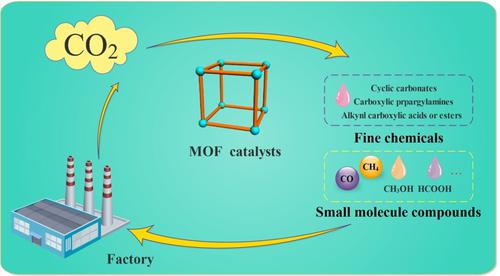当前位置:
X-MOL 学术
›
Chin. J. Chem.
›
论文详情
Our official English website, www.x-mol.net, welcomes your feedback! (Note: you will need to create a separate account there.)
Recent Advances on Metal‐Organic Frameworks in the Conversion of Carbon Dioxide
Chinese Journal of Chemistry ( IF 5.4 ) Pub Date : 2020-09-05 , DOI: 10.1002/cjoc.202000357 Xiongli Liu 1 , Jinli Li 1 , Na Li 1 , Baiyan Li 1 , Xian‐He Bu 1, 2
Chinese Journal of Chemistry ( IF 5.4 ) Pub Date : 2020-09-05 , DOI: 10.1002/cjoc.202000357 Xiongli Liu 1 , Jinli Li 1 , Na Li 1 , Baiyan Li 1 , Xian‐He Bu 1, 2
Affiliation

|
With the development of modern industry, global warming is becoming a challenging issue due to the emissions of large quantities of greenhouse gases, mainly carbon dioxide (CO2). The conversion of CO2 to useful compounds is considered as an effective and economic way to solve such a climate problem. Metal‐organic frameworks (MOFs) are an emerging class of porous crystalline materials that have shown great potential in the conversion of CO2. The advantages of MOFs in CO 2 conversion lie in their high surface areas, adjustable pore size, and high porosity. More importantly, desirable functional sites can be easily designed and precisely installed to the pore wall of target MOFs by pre‐assembly and/or post‐synthetic modification (PSM) ways. This review summarizes the recent advances in constructing MOF catalysts for the application in CO2 conversion. We believe that the design and synthesis of MOF catalysts for CO2 conversion can be a promising way to solve the “greenhouse effect”.
中文翻译:

金属有机框架在二氧化碳转化中的最新进展
随着现代工业的发展,由于大量温室气体(主要是二氧化碳(CO 2))的排放,全球变暖正成为一个具有挑战性的问题。将CO 2转化为有用的化合物被认为是解决这种气候问题的有效且经济的方式。金属有机骨架(MOF)是一类新兴的多孔晶体材料,在CO 2转化中显示出巨大潜力。MOF在CO 2中的优势转化率取决于它们的高表面积,可调节的孔径和高孔隙率。更重要的是,可以通过预组装和/或合成后修饰(PSM)的方式轻松地将所需的功能位点设计并精确地安装到目标MOF的孔壁上。这篇综述总结了构建用于CO 2转化的MOF催化剂的最新进展。我们认为,用于CO 2转化的MOF催化剂的设计和合成可以解决“温室效应”。
更新日期:2020-09-05
中文翻译:

金属有机框架在二氧化碳转化中的最新进展
随着现代工业的发展,由于大量温室气体(主要是二氧化碳(CO 2))的排放,全球变暖正成为一个具有挑战性的问题。将CO 2转化为有用的化合物被认为是解决这种气候问题的有效且经济的方式。金属有机骨架(MOF)是一类新兴的多孔晶体材料,在CO 2转化中显示出巨大潜力。MOF在CO 2中的优势转化率取决于它们的高表面积,可调节的孔径和高孔隙率。更重要的是,可以通过预组装和/或合成后修饰(PSM)的方式轻松地将所需的功能位点设计并精确地安装到目标MOF的孔壁上。这篇综述总结了构建用于CO 2转化的MOF催化剂的最新进展。我们认为,用于CO 2转化的MOF催化剂的设计和合成可以解决“温室效应”。



























 京公网安备 11010802027423号
京公网安备 11010802027423号